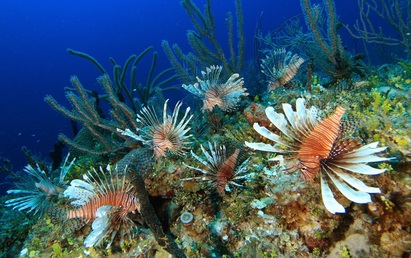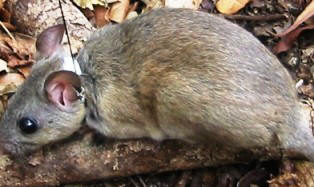What's the problem with Lionfish?
A few Lionfish Quickfacts (provided by NOAA, REEF, Simon Fraser University and USGS):
- In the Caribbean a single female Lionfish can spawn over ~2 million eggs/year
- Reproduction occurs throughout the year about every 4 days
- Lionfish eggs are held together in a gelatinous mass and are dispersed at the ocean’s surface by currents, where their larval duration is ~26 days
- Lionfish are generalist carnivores that consume >56 species of fish and many invertebrate species, with prey up to half the Lionfish’s body size
- On heavily invaded sites, Lionfish have reduced their fish prey by up to 90% and continue to consume native fishes at unsustainable rates
- Native predators exhibit avoidance for Lionfish
- Lionfish have very few parasites compared to native species
In summary: They were introduced by mankind, wipe out local fish populations, have no natural predators, and reproduce like crazy. The result, if unchecked, likely looks like this:
 |
| Image provided by REEF from a dive site in the Bahamas |
Perhaps an image from the USGS Lionfish sightings database can help people visualize the problem. In 2007, Lionfish were first sighted off the Bahamas. The current distribution map from the USGS database is as follows:
What can you currently do about it?
- Report lionfish sightings at http://www.reef.org/programs/exotic/report or http://nas.er.usgs.gov/sightingreport.asp
- Attend a lionfish derby: http://www.reef.org/lionfish/derbies
- Attend a lionfish workshop to learn more about the problem and what you can do about it: http://www.reef.org/lionfish/workshops
Perhaps one of the most potentially effective solutions is to eat them!
Check out some Lionfish Recipes or get your own cookbook: |
| The cookbook from REEF has a lot of info about Lionfish including how to capture, clean and prepare them. |
Why an Android App?
 A lot of divers come to the Florida Keys. Many of them have heard of the Lionfish problem. Many of them want to do something about it. Yet, I hear many ask, "Where are the lionfish?"
A lot of divers come to the Florida Keys. Many of them have heard of the Lionfish problem. Many of them want to do something about it. Yet, I hear many ask, "Where are the lionfish?"
In contrast, local divers who dive lesser-known dive sites frequently are overwhelmed by how many Lionfish there are. I believe that in the areas we dive a lot, commercial dive operators are better trained in removing the Lionfish and do this regularly. So, the most frequently dived sites are probably the most free of Lionfish.
I'm thinking it would be great to connect these folks. With smartphones and social apps available today, this seems like a problem that technology can help. Having previously run a software development company and worked on many mobile applications, I feel like I am in a position to help.
So, I started working on an Android Lionfish Tracker App. Here are a couple of screen captures. The app displays an icon representing Lionfish sightings. I also added a diver icon to represent dive sites. The icons are ones that were freely available that I've modified slightly for this app. When you click on either, more information is presented. If you press and hold, even more information will be presented. I'm building the app up incrementally, testing it and getting feedback along the way. I will likely also publish the source code under a GPL licenses (Open Source Software).
How can you help this project?
Think this project is worthwhile? Want to help? First, start by doing one of the items in the "What can you currently do about it?" section above. Then, the following would also be appreciated:
- Feedback! Comments, concerns, questions, or suggestions are all welcome. Please let me know what you think I'm doing either right or wrong. Words of encouragement are certainly welcome!
- If you are in South Florida, please consider becoming an alpha/beta tester.
- If you think you can offer help, please contact me via Twitter, Google+, Facebook, LinkedIn, Email, etc. My username is "jasonnocks" on all of them.
- Monitor this project. Share it with your immediate friends/associates. If you know someone that you think could help, please put us in touch. If you know someone that you think would be able to benefit, let them know about it.
I really need to start putting together some alpha/beta testers. I'll be contacting dive professionals in the Key Largo area soon to see who wants to be an alpha/beta tester. If you are excited about that idea, please let me know. If not, feel free to say so.
REEF has done a great job making people aware of the problem. I hope this helps with the effort.
Thank you in advance.
Cheers,










